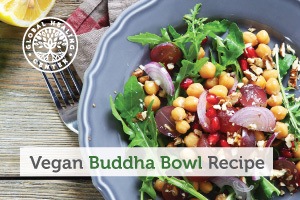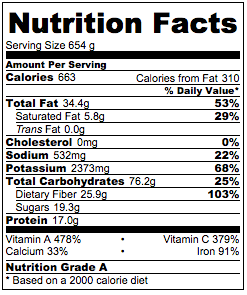
If you’ve scrolled through your social media in the last year, you’ve probably come across a slew of veggie-filled dishes called “Buddha bowls.” They are usually deep, round bowls filled with healthy cooked and raw vegan ingredients that fill you up and keep you sustained for hours. The easiest way to throw these bowls together is to prepare a few different ingredients one evening during the week, particularly the cooked ingredients, and use them to make quick and fresh meals throughout the week.
You can follow the original Nutrition Stripped recipe, but Buddha bowls are an infinitely flexible concept. All you have to do is arrange some vegan protein, complex carbohydrates, and a healthy source of fat on a bed of raw leafy greens. I like to add a few odds and ends to bump up the flavor and texture of my Buddha bowls, and it's a fantastic way to use up leftovers, like sweet potatoes.
Sweet Potatoes: Delicious and Nutritious
Feel free to omit or add any ingredients to this recipe, but don’t skimp on the sweet potatoes. In terms of nutrients per dollar, sweet potatoes provide an excellent return on your investment. They’re exceptionally nutrient dense and are a rich source of potassium, manganese, vitamin A, and vitamin C.[1] Unlike white potatoes, sweet potatoes have a low glycemic load, so you get the benefit of sustained energy when you choose sweet potatoes over other simple starchy foods.[2]
Sweet potatoes might actually contribute to a long, healthy life — if you’re willing to eat enough of them. The traditional diet of Okinawa, a Japanese prefecture, is almost 70% complex carbohydrates and characterized by foods that have a low glycemic load but are exceptionally high in antioxidants, like leafy green vegetables and the Okinawan purple sweet potato.[3]
This traditional diet may help the people of Okinawa live remarkably long lives; the average lifespan is about 80 years for men and 87 years for women.[4] In one study, blood tests of Okinawan centenarians revealed they had less oxidative stress than the control group of adults in their 70s.[5]
You might be able to find purple sweet potatoes locally. They have a bold purple flesh, but the color of the skin may differ depending on which variety you find in your area. In the U.S., you’re more likely to find Stokes Purple sweet potatoes, which have a dark maroon skin. The rich color of the skin and flesh is due to the concentration of anthocyanins, a powerful antioxidant. These antioxidants are actually more effective at trapping free radicals (and preventing oxidative stress) than the anthocyanins in red cabbage and grapes.[6] Look for these deep-hued potatoes at your local farmer's market or organic grocery store in late summer through April. Try to use them within 2 weeks as they won’t last as long as white and yellow potatoes.[7] When cooked, purple sweet potatoes maintain their gorgeous color and they look absolutely incredible in this Buddha Bowl recipe.
I also took the opportunity to include one of my favorite autumnal foods — lightly crisped, roasted Brussels sprouts. You only need a few for this recipe, and they taste great tossed with minced garlic, fresh rosemary, and olive oil.
Sweet and Savory Vegan Buddha Bowl

- Prep time: 20 minutes
- Cook time: 30-45 minutes
- Total time: 65 minutes
- Serves: 1
Equipment
- Roasting pan
- Parchment paper
- Medium-sized mixing bowl
- Large salad bowl
Ingredients
- 2 cups loosely packed organic field greens
- 1 cup organic arugula or baby kale
- 1 large roasted organic sweet potato, purple or orange, cubed and tossed in olive oil
- 5-10 fresh Brussels sprouts, halved and tossed in olive oil
- 2 tablespoons organic olive oil
- ½ cup organic carrots, julienned or spiralized
- ¼ cup organic cucumber, halved and thinly sliced
- ¼ of organic avocado, peeled and cubed
- 3 tablespoons nutritional yeast (optional)
- 3 tablespoons of organic hemp or flax seeds
- 2 tablespoons of your favorite hummus
- 1 ½ tablespoons fresh-squeezed organic lemon juice, or to taste
- 2 tablespoons organic apple cider vinegar
- Himalayan crystal salt to taste
- ¼ teaspoon black or mixed ground pepper, or to taste
- Dash of cayenne pepper (optional)
Directions
- Line a roasting pan with parchment paper.
- Toss diced sweet potatoes in 2 tablespoons of olive oil, coating evenly. Set bowl aside for Brussels sprouts in step 4.
- Roast the sweet potatoes for 30-45 minutes at 375° F.
- Toss Brussels sprout halves in remaining oil from the bowl, coating evenly.
- Spread raw, halved Brussels sprouts on a separate, parchment-covered pan. Roast for 25 minutes. (If you want to save on dishes, you could also add them to the sweet potato pan once the potatoes only have 25 minutes remaining on the timer.)
- Fill a large salad bowl with greens and combine.
- Allow roasted veggies to cool for a few minutes before adding them to the greens.
- During in this time, stir hummus, apple cider vinegar, lemon juice, and nutritional yeast together for a thick dressing.
- Top your Buddha bowl with the roasted vegetables and remaining ingredients (for the best presentation, carefully arrange ingredients into their own sections).
- Add salt and pepper to taste. Enjoy!
What Other Nutrients Does This Buddha Bowl Provide?
The dark leafy greens in this recipe are a rich source of fiber, folate, and vitamins A, C, E, and K.[8, 9] Conveniently, the monounsaturated and polyunsaturated fat from the avocado, olive oil, and flax seeds[10] will help your small intestine absorb vitamins A and K from the leafy greens and carrots, since the vitamins are fat soluble. The apple cider vinegar, which offers a multitude of benefits, will help emulsify the fats for absorption.
References (10)
- “Sweet potato, cooked, baked in skin, without salt [Sweetpotato] Nutrition Facts & Calories.” 2014. Web. 20 Sept. 2016.
- “Winter 2007 - researchers reveal sweet potato as weapon against diabetes.” n.d. Web. 20 Sept. 2016.
- Willcox, Donald Craig, Giovanni Scapagnini, and Bradley J. Willcox. “Healthy Aging Diets Other Than the Mediterranean: A Focus on the Okinawan Diet.” Mechanisms of Ageing and Development s 136–137. (2014): 148–162. Web. 20 Sept. 2016.
- Life Expectancy by Prefecture in Japan. How much is it in Tokyo?, 8 Dec. 2014. Web. 20 Sept. 2016.
- Suzuki, Makoto, et al. “Oxidative Stress and Longevity in Okinawa: An Investigation of Blood Lipid Peroxidation and Tocopherol in Okinawan Centenarians.” Current Gerontology and Geriatrics Research 2010. (2011): n.pag. Web. 20 Sept. 2016.
- Kano, M, et al. “Antioxidative Activity of Anthocyanins from Purple Sweet Potato, Ipomoera Batatas Cultivar Ayamurasaki.” Bioscience, biotechnology, and biochemistry. 69.5 (2005): 979–88. Web. 20 Sept. 2016.
- Hard, Lindsay-Jean. “Purple Sweet Potatoes and How to Use Them.” How to Cook. Food52, 15 Nov. 2014. Web. 20 Sept. 2016.
- “Dark Green Leafy Vegetables: USDA ARS.” 13 Aug. 2016. Web. 20 Sept. 2016.
- “Older Adult Health Facts: Eat plenty of Fruits and Vegetables.” n.d. Web. 20 Sept. 2016.
- “Protein, Carbohydrates & Fats.” NIH: National Institute on Aging. n.d. Web. 20 Sept. 2016.
†Results may vary. Information and statements made are for education purposes and are not intended to replace the advice of your doctor. If you have a severe medical condition or health concern, see your physician.



